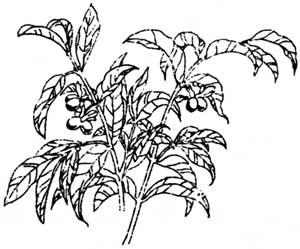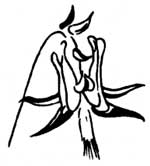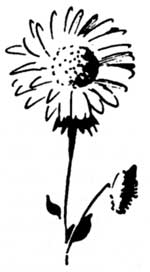Rubber rabbitbrush, Chrysothamnus nauseosus, is a relatively small shrub, being six inches to two feet in height. Its yellow flowers appear late in the summer and can be seen along the Garfield Peak Trail and at places like the Wineglass near the caldera’s edge.
 black twinberry L. Howard Crawford, Nature Notes from Crater Lake, Vol. 8, No. 3 (September 1935), p. 7. |
Sierra willow, Salix sitchensis, and Bush honeysuckle, Lonicera involucrata, both have long, large leaves, but they are easy to tell apart in the late summer. The willow, which ordinarily prefers wet habitats such as stream sides, develops seeds that give the appearance of small bits of cotton. Bush honeysuckle (which is sometimes called black twinberry) produces pairs of dark purple berries which are a favorite food of the Clark’s nutcracker, Nucrifraga columbiana. These berries can stain the bird’s beak bright purple, something which is often seen around Rim Village where this species of honeysuckle is common.
Botanists experienced difficulty in locating Mountain maple, Acer glabrum, from which cuttings could be obtained in the park. They eventually found several of these shrubs in a moist area near the east. As a result, several mountain maples can be seen near the southwest corner of the kitchen.
Mountain ash, Sorbus sitchensis, is fairly common around the lodge. Shrubs planted in the 1930s are about five feet tall, and in need of pruning. The leaves of mountain ash are composed of seven to eleven leaflets end have a shiny green color. This shrub produces red berries in the fall that are eaten by migrating cedar waxwings, Bombycilla cedrorum.
Although they are the smallest component of the landscape project, perennial wildflowers are, at times, its most colorful. Like the shrubs, these herbs provide an understory for trees and complement the grass-like native sedges. From midsummer until late fall, a number of perennial wildflowers transplanted into beds around the lodge may be seen.
 columbine Walter Rivers, Crater Lake Nature Notes, Vol. 14, No. 1 (1948), p. 11. |
As its name implies, the pearl-everlasting, Anaphalis margaritacea, has a long-lived flower. Its papery-white petals appear in July and last until snowfall. Growing from one to two feet tall, it is commonly seen along park roads where runoff creates moist conditions.
Visitors from the Rocky Mountains who are familiar with the pastel to deep blue of columbines in that region may be surprised to find the red and yellow Sitka columbine,Aquilegia formosa, around the lodge. This species of columbine is the only one in the park, but is common to forests along the Pacific slope. It is frequently seen during July and August in the Cascade Crest Wildflower Garden near Park Headquarters.
 cascade aster Rivers, op. cit. |
Cascade aster, Aster ledophyllus var. covillei, has purple flowers with approximately eight radiating petals. This is the most common of the four asters in the park and was easily propagated from seed for transplanting at the lodge. It is often seen from July to September around the rim, usually in dry places.
Sulfur eriogonum, Erigonum umbellatum, is found in dry areas throughout the park and is sometimes known as wild buckwheat. This plant has small yellow flowers atop a leafless four to twelve inch stem. Its paddle-shaped, silver green leaves appear at the base. Another member of this genus, Eriogonum pyrolaefolium var. coryphaeum, is somewhat similar in appearance but has white flowers. E. pyrolaefolium is usually known as Dirty socks because of its objectionable odor.
Cliff penstamon, Penstamon rupicola, is an attractive woody plant with purplish pink flowers that grows in rock crevices. Often found on ledges along the Garfield Peak Trail, cliff penstamon has been planted in the rocks which help stabilize the rootball of a mountain hemlock transplanted at the east end of the lodge.
As intended, the trees, shrubs, and flowers around Crater Lake Lodge combine to help blend the building with its surroundings. Although they represent only a small part of the park’s flora, these species are also useful starting points in demonstrating how organisms adapt to exposed places at higher elevations. If nothing else, the plants adjacent to Crater Lake Lodge demonstrate that life can persist in an environment where natural succession is slow or even absent for long periods after disturbances occur.
Erik Hendrickson is a structural engineer with the National Park Service in Denver, Colorado. He helped direct the rehabilitation of Crater Lake Lodge.
Steve Mark is the park historian at Crater Lake. He has been editor of Nature Notes since its revival in 1992.


